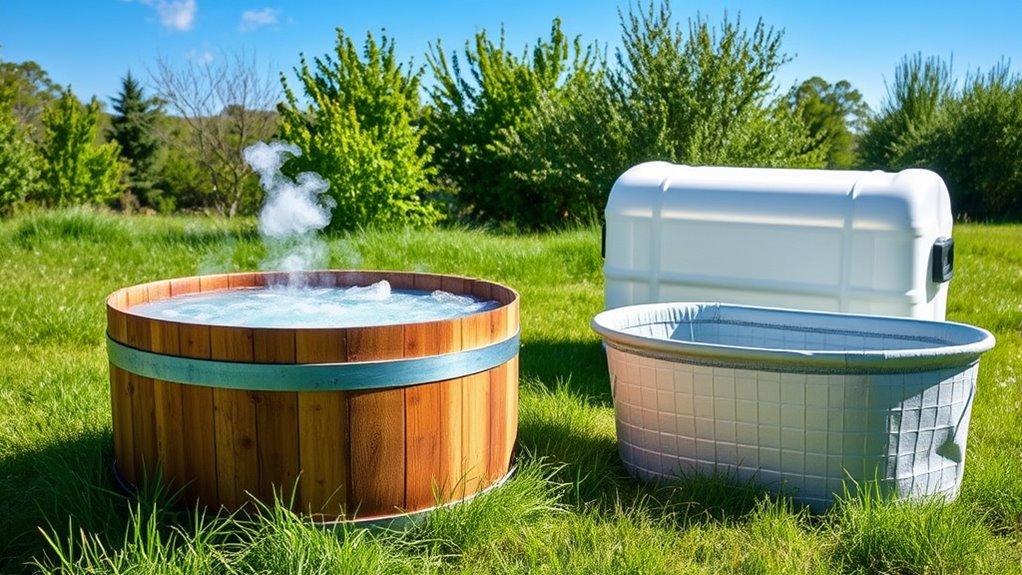If you’re exploring portable cold plunge options, tubs, barrels, and stock tanks are great choices that offer flexibility and affordability. These options are lightweight, durable, and easy to move, making them ideal for both indoor and outdoor use. Made from materials like polyethylene or rubber, they resist weather and require minimal maintenance. Want to learn how to choose and care for your portable plunge setup? Keep going to discover useful tips and tricks.
Key Takeaways
- Portable cold plunges include tubs, barrels, and stock tanks, offering flexible and cost-effective cold therapy solutions.
- Made from lightweight, durable materials like polyethylene, resin, or rubber for easy transport and weather resistance.
- These options require minimal structural support compared to permanent concrete or metal installations.
- Regular maintenance, including cleaning and inspecting for damage, extends the lifespan of portable cold plunges.
- Temperature management can be optimized with chillers, covers, or pumps to maintain desired cold water conditions.

If you’re looking to enjoy the benefits of cold plunging without the hassle of permanent installations, portable cold plunge options are an excellent choice. These setups, often consisting of tubs, barrels, or stock tanks, provide a flexible and cost-effective way to incorporate cold therapy into your routine. When selecting a portable option, you’ll find that alternative materials like polyethylene, resin, or rubber are popular because they’re lightweight, durable, and resistant to the elements. These materials make transportation easier and often require less structural support than traditional concrete or metal tubs. Plus, they tend to be more affordable upfront, making them accessible for most budgets.
Portable cold plunge options offer flexible, durable, and affordable solutions for cold therapy enthusiasts.
Maintaining your portable cold plunge is straightforward once you keep a few tips in mind. Regular cleaning is essential to prevent algae and bacteria buildup, especially if you plan to use the tub frequently. Use mild, non-abrasive cleaners and rinse thoroughly after each use. Drain and refill the tub periodically to ensure the water remains fresh and to help control mineral deposits or dirt that may accumulate over time. When it comes to alternative materials, check manufacturer recommendations for cleaning and maintenance, as some plastics or resins may require specific products or methods to avoid damage.
Another key maintenance tip involves protecting your portable tub from the elements. If you’re using it outdoors, consider covering it when not in use to prevent debris from falling in and to reduce exposure to UV rays, which can degrade certain plastics over time. Inspect the tub regularly for cracks, leaks, or signs of wear, especially after harsh weather conditions. If you notice any damage, repair kits are often available, or you might need to replace the affected part to keep your cold plunge safe and functional.
Heating or cooling your portable tub can also be managed effectively with supplemental equipment like submersible pumps, chillers, or heaters. These devices help you maintain the desired water temperature for ideal cold plunging. Keep electrical components dry and follow safety guidelines to avoid accidents. Using a cover or tarp when not in use can also help maintain temperature and keep your setup clean.
Frequently Asked Questions
How Long Does It Take to Fill a Portable Cold Plunge?
Filling a portable cold plunge typically takes between 30 minutes to an hour, depending on your water source and its flow rate. If you have a high-pressure hose, it fills faster, while a standard tap may take longer. To estimate filling time, consider your water flow rate and the plunge’s capacity. Planning ahead guarantees you have enough time for a full, cold soak without surprises.
What Safety Precautions Are Recommended for Cold Water Immersion?
Imagine you’re steering icy waters; safety is your anchor. To reduce hypothermia risk, always monitor water temperature closely and avoid plunging if it’s too cold. Limit immersion time, typically under 10 minutes, and listen to your body’s signals. Wear a thermometer, stay warm before and after, and never immerse alone. These precautions keep your cold water experience safe and invigorating, like a sturdy boat amidst icy seas.
Can Portable Cold Plunges Be Used Indoors?
Yes, you can use portable cold plunges indoors if you consider space and ventilation. Make sure the area has enough room for safe entry and exit, and guarantee proper ventilation to prevent moisture buildup. Check that your flooring can support the weight of the tub, barrel, or stock tank when filled. Use waterproof barriers if needed, and keep electrical outlets away from water to avoid hazards.
What Maintenance Is Required for Portable Cold Plunge Tubs?
You should regularly maintain your portable cold plunge tub by checking water treatment and adjusting temperature regulation. Change the water weekly or as needed to prevent bacteria buildup, and use appropriate sanitizers. Keep the water’s temperature consistent by monitoring the thermostat, and clean the tub’s surfaces frequently. Regular maintenance guarantees safe, effective use, prolongs the tub’s lifespan, and keeps your cold plunge experience enjoyable and hygienic.
Are Portable Cold Plunges Energy-Efficient?
You’re right to ask if portable cold plunges are energy-efficient. They can be, especially if you focus on energy consumption and insulation requirements. Proper insulation helps retain cold temperatures longer, reducing energy use. While they may not compete with built-in systems, choosing well-insulated options and managing your temperature settings can save money and energy. It’s a case of “a penny saved is a penny earned,” so pick wisely!
Conclusion
No matter which portable cold plunge you choose—be it a tub, barrel, or stock tank—you’re opening the door to invigorating, revitalizing dips that energize your day. Think of these options as your personal oasis, ready to cool your body and clear your mind whenever you desire. With a little setup, you’ll have a portable sanctuary for wellness that’s as easy to enjoy as a breath of fresh, icy air—an invigorating escape just a splash away.









